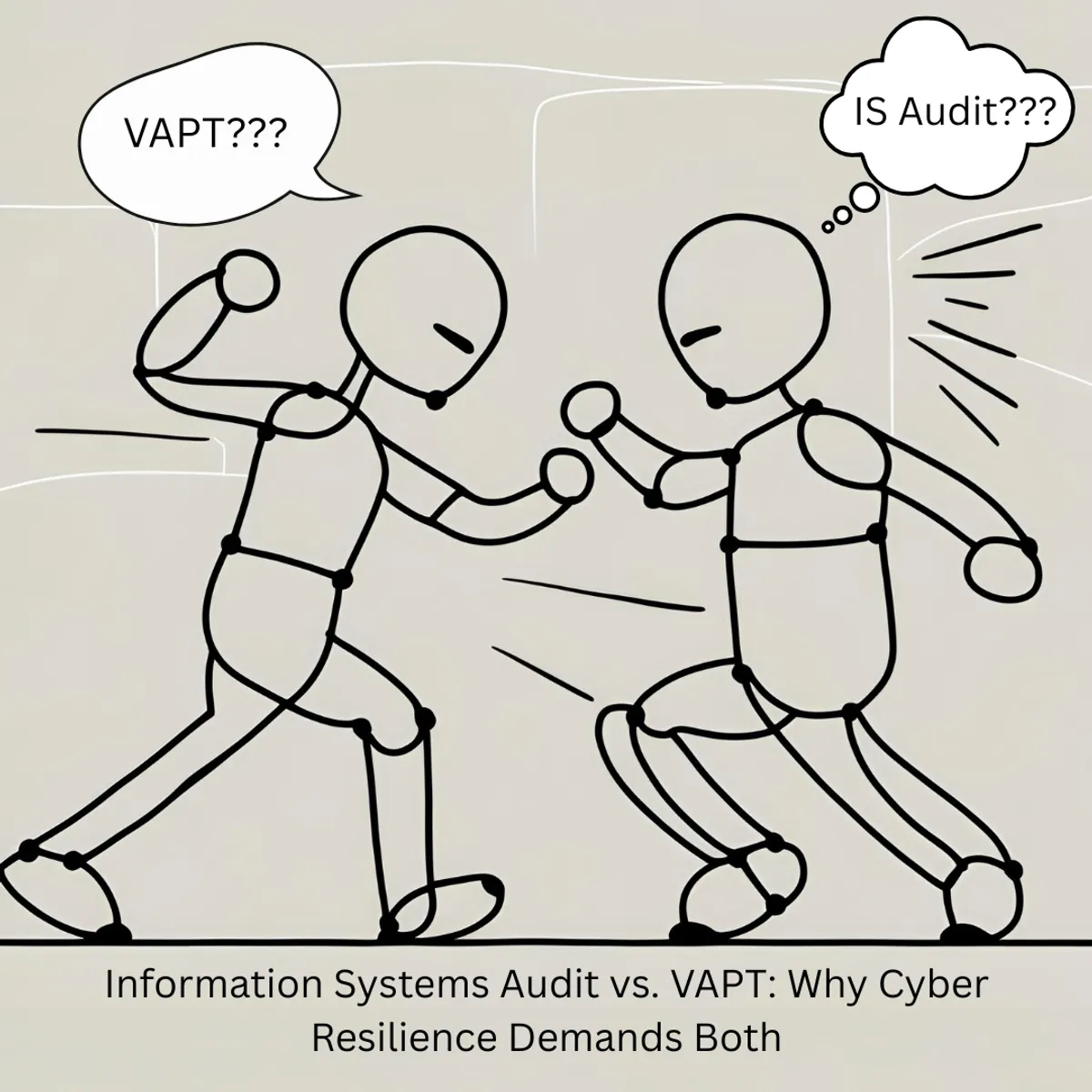Information Systems Audit vs. VAPT: Why Cyber Resilience Demands Both
In today’s hyper-connected digital landscape, cybersecurity is not a one-dimensional effort. As organizations face increasingly sophisticated threats, it becomes evident that technical defenses alone are insufficient. Governance, policy, and operational maturity must intersect with tactical, real-world threat validation.
Two commonly referenced — and often misunderstood — methodologies stand out in the enterprise security strategy: Information Systems Audit (IS Audit) and Vulnerability Assessment and Penetration Testing (VAPT). While they are often perceived as interchangeable, they are fundamentally distinct in purpose, scope, and execution.
This article demystifies IS Audit and VAPT, articulates their strategic interplay, and outlines why a siloed approach to either is a risk in itself.
1. What Is an Information Systems Audit?
An Information Systems Audit is a formal evaluation of an organization’s IT infrastructure, governance, internal controls, and regulatory compliance. Conducted by internal or external auditors, its objective is to determine whether IT assets are managed in a way that ensures integrity, confidentiality, availability, and alignment with business objectives.
Key Objectives:
- Governance & Control Assurance: Evaluate IT governance models, control frameworks, and alignment with best practices such as COBIT, ISO/IEC 27001, and NIST CSF.
- Regulatory Compliance: Ensure adherence to sector-specific standards (e.g., HIPAA, GDPR, SOX).
- Process and Policy Review: Assess change management, access controls, data governance, and business continuity planning.
- Risk Mitigation Advisory: Identify process-level risks and provide control-strengthening recommendations.
Typical Deliverables:
- Risk-based audit report with findings and recommendations
- Control maturity evaluation (e.g., maturity scoring)
- Compliance gap analysis
- Suggested remediation roadmap
2. What Is Vulnerability Assessment and Penetration Testing (VAPT)?
VAPT represents a dual-layered approach to evaluating an organization’s exposure to technical vulnerabilities. It goes beyond control and policy assessments, offering a real-world view into how a threat actor might compromise systems, applications, or networks.
Two Interdependent Components:
-
Vulnerability Assessment
- Automated scanning of systems to identify known vulnerabilities.
- Emphasis on breadth and detection across a wide digital surface.
- Typically uses tools like Nessus, OpenVAS, or Qualys.
-
Penetration Testing (Pentest)
- Manual, simulated attack scenarios by ethical hackers.
- Explores exploitability and potential impact of vulnerabilities.
- Focuses on depth, chaining weaknesses to simulate real attacks.
Key Objectives:
- Identify security misconfigurations, outdated software, and exploitable flaws
- Test real-world scenarios like privilege escalation or lateral movement
- Validate the effectiveness of existing security mechanisms
- Deliver practical, risk-prioritized remediation guidance
Typical Deliverables:
- Detailed technical report with CVSS-based risk ratings
- Proof-of-concept (PoC) for successful exploitations
- Executive summary for stakeholders
- Actionable remediation plan
3. IS Audit vs. VAPT: A Strategic Comparison
| Dimension | IS Audit | VAPT |
|---|---|---|
| Primary Objective | Evaluate governance, control effectiveness, compliance | Identify and exploit technical vulnerabilities |
| Scope | Policies, standards, IT processes, internal controls | Systems, networks, applications, and endpoints |
| Methodology | Interviews, document reviews, control testing | Automated scanning, manual penetration, exploit chaining |
| Tools & Frameworks | COBIT, ISO 27001, NIST CSF, audit checklists | Nessus, Burp Suite, Metasploit, OWASP Top 10 |
| Frequency | Annual or bi-annual (audit cycle-based) | Quarterly or after major system/infrastructure changes |
| Deliverable Focus | Audit findings, policy recommendations, compliance gaps | Vulnerability report, exploit evidence, remediation guidance |
| Audience | Risk, compliance, executive management | IT security teams, DevOps, infrastructure leads |
4. Perspective Matters: Strategic vs. Tactical Security
Understanding the intent and vantage point of each approach is crucial to appreciating their roles:
IS Audit — The Governance Lens
Think of the IS Audit as a high-altitude inspection. It ensures your security structure is sound, that your organization follows what it preaches, and that there’s accountability in processes. It’s preventative in nature, rooted in risk management, and essential for regulatory confidence.
- “Are policies defined, communicated, and enforced?”
- “Do we have controls that align with accepted standards?”
- “Can we prove it if audited?”
VAPT — The Attacker’s Lens
VAPT, on the other hand, takes on the mindset of a threat actor. It’s adversarial by design. It doesn’t care if the policies exist — it tests whether they actually work under fire.
- “Can I bypass MFA through a misconfigured API?”
- “Does this outdated server allow me to pivot to a production database?”
- “Can I exfiltrate data from your cloud infrastructure in under 10 minutes?”
5. Why You Need Both: The Case for Integration
Conducting only an IS Audit without VAPT is like evaluating a security protocol without ever testing if it can be broken. Conversely, relying solely on VAPT might surface technical flaws but miss systemic governance issues that allow those flaws to persist.
Combined, You Gain:
- Holistic Risk Visibility: See both control deficiencies and technical vulnerabilities.
- Regulatory & Real-World Readiness: Align with compliance standards and actual threat models.
- Proactive Security Posture: Find and fix weak links before adversaries exploit them.
- Stronger Stakeholder Confidence: Demonstrate mature, well-rounded cybersecurity assurance.
Security is not about choosing governance over testing, but orchestrating both to work in concert.
6. Closing Thoughts
Cybersecurity is not a checkbox—it’s an evolving narrative of trust, resilience, and adaptability. As businesses digitize, the surface area for risk expands, and so must the frameworks that protect it.
- An IS Audit ensures that your security architecture is thoughtfully designed and correctly managed.
- VAPT validates whether that architecture can withstand the real-world tactics of adversaries.
Together, they provide the dual assurance your organization needs—one from the boardroom, and the other from the battlefield.
Let your cybersecurity investments reflect the sophistication of the threats they guard against. Embrace both audit and testing not as isolated tasks, but as pillars of a resilient digital enterprise.
References
- ISACA. COBIT 2019 Framework. https://www.isaca.org/resources/cobit
- ISO/IEC. 27001:2013 Information Security Management. https://www.iso.org/isoiec-27001-information-security.html
- NIST. Cybersecurity Framework 1.1. https://www.nist.gov/cyberframework
- OWASP. Top 10 Application Security Risks. https://owasp.org/Top10/
- PCI SSC. Penetration Testing Guidance. https://www.pcisecuritystandards.org
- HIPAA Journal. HIPAA Compliance Checklist 2024. https://www.hipaajournal.com/hipaa-compliance-checklist/
